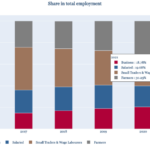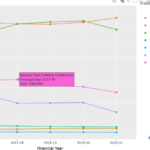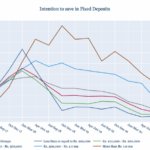CEDA-CMIE: In 5 years, youth employment reduces by 30 percent
Key findings:
- India’s total employed numbers (aged 15 or above) had not reached pre-pandemic levels till December 2021, despite recovery.
- For India’s youth (aged 15 to 29), employed numbers in Oct-Dec 2021 – 72.7 million – were 13 percent lower than the same quarter in 2019 (pre-pandemic), and 30 percent lower compared to the January-March 2016 quarter (103.8 million).
- This has not led to a commensurate increase in the numbers of those ‘unemployed but willing to work and actively looking for jobs’ (UEWL) in the same period. India’s youth labour force (employed+UEWL) has shrunk by 22 percent from 134.1 million in Jan-Mar 2016 to 104.3 million in Oct-Dec 2021. Compared to 2019, this represents a 10.62 percent decline over the last two years.
- 15-29-year-olds made up 25.6 percent of all employed workers in 2016, which declined to 21 percent in 2019. In 2021, this number decreased to just 18.2 percent.
- All states going to polls registered declines in youth employment numbers as compared to 2019. The largest declines were seen in Goa (42 percent decline) and Uttarakhand (43 percent decline). UP registered a 17 percent decline while Punjab showed a 15 percent decline.
- The share of 50-59-year-old workers has increased from 16 percent in 2016 to 24.6 percent in 2021.
In our last CEDA-CMIE Bulletin we looked at state-wise changes in employment by gender between January 2019 and September 2021. In this bulletin we look at state-wise employment changes by age-groups using CMIE’s state-wise employment data from Jan-Mar 2019 to Oct-Dec 2021 and all-India data from Jan-Mar 2016 to Oct-Dec 2021.
We begin by examining the labour force, defined here as the sum of those employed and those unemployed, but active and willing to work (UEWL).
Figure 1a reveals quarterly changes in India’s labour force for all workers between January 2016 and December 2021. For example, the total number of employed in Q1-2019 (Jan-Mar) was 403.6 million with 30 million UEWL, making it a 433.6 million strong labour force. The figure shows that India’s labour force is still marginally lower than what it was in March 2020 (when Covid-19 pandemic lockdowns were imposed).
The share of employed (as part of the labour force) has remained close to 92-93 percent since Jan-Mar 2019, except in Q2-2020 (Apr-Jun) when it declined to 82 percent. This was the quarter when economic activity came to an almost complete halt on account of Covid-19 lockdowns across the country.
Figure 1a
Fall in Youth Employment
Figure 1a shows changes in the size of India’s total labour force in this period, and Figure 1b shows the size of the youth labour force (those in the 15-29-years age group who are in the labour force) between Q1-2016 (Jan-Mar) and Q4-2021 (Oct-Dec). This age group represents new entrants to the labour force, and the state of employment amongst this cohort represents how easy or difficult it is for young, first-time workers to secure entry into the job market.
Figure 1b shows that while 103.8 million 15-29-year-olds were employed in Q1-2016, this number decreased by 30 percent to 72.7 million in Q4-2021. The total size of the 15-29-year-old labour force in Q1-2016 was 134.1 million; by Q4-2021, this had declined by 22 percent to 104.3 million. This shows that while 30 percent fewer 15-29-year-olds were employed in 2021 (as compared to 2016), many did not add to UEWL numbers. It is possible that they searched for a job for a few months, and then opted to exit after not getting any employment. This points to long-term unemployment.
If we compare pre- and post-pandemic periods, we can find that the number of 15-29-year-olds employed in Q4-2021 was 13 percent lower than Q4-2019 (pre-pandemic). Even the labour force (15-29) declined by 9 percent in this period.
This sharp decline in employment (and labour force) of 15-29-year-olds has been a steady phenomenon since 2016. The Covid-19 pandemic has only exacerbated a pre-existing decline.
Figure 1b
How Does Youth Employment (and Unemployment) vary across states?
In Figure 2a we look at average monthly youth employment across 27 Indian states or Union Territories in 2019, 2020, and 2021.
In 2019, at the national level, the average monthly employment levels of those aged 15-29 was around 84.9 million. This fell by 15 percent to 71.8 million in 2020, the year the Covid-19 pandemic struck. There was a slight recovery in employment numbers to 72.6 million in the year 2021. On a year-on-year basis, this represented an increase of 1 percent. However, if we compare this to the pre-pandemic year 2019, this marks a decline of 14.5 percent. Lower employment in 2021 than the pre-pandemic period points to sluggish economic activity that provides fewer opportunities for young workers.
Between 2019 and 2020, the highest fall in employment for 15-29-year-olds was seen in Delhi with a decline of 38 percent (reducing from 1.6 million in 2019 to 1 million in 2020). Delhi was followed by J&K – with a decline of 37 percent – and Haryana with a decline of 35 percent.
On comparing 2021 with the pre-pandemic year 2019, we find that Uttarakhand saw the sharpest decrease in employment for 15-29-year-olds with a decline of 43 percent followed by Goa with a decline of 42 percent. In Delhi, the 2021 numbers are still 39 percent lower than 2019 and in Haryana they are 40 percent lower.
If we look at states going to polls in February and March 2022, we see that in Uttar Pradesh average monthly employment for 15-29-year-olds in 2021 was 17 percent lower than 2019. In Uttarakhand it was 43 percent lower, in Punjab 15 percent lower and 42 percent lower in Goa.
Figure 2a
In Figure 2b we look at average monthly UEWL numbers across 27 Indian states and UTs for the young in 2019, 2020, and 2021. Across India, 29.6 million 15-29-year-olds were willing to work and actively looking for jobs every month in 2019. This increased to 30.1 million in 2020 when the pandemic struck, yet declined to 29.7 million in 2021, a 1 percent decline when compared to the pre-pandemic period. The average size of the labour force of 15-29-year-olds in 2019 was 114.5 million, falling to 101.9 million in 2020 before rising slightly to 102.3 million in 2021, a 11 percent decline when compared to 2019.
Figure 2b
On the face of it, declining unemployment numbers signal a healthy recovery. However, the reality is more complex. Average monthly employment in India for 15-29-year-olds in 2020 was 13.1 million lower than 2019, but the increase in those actively looking for jobs was only 0.55 million. Thus, over 12.5 million 15-29-year-olds not only lost employment, but they also stopped looking for new jobs.
The causes for this reduction deserves greater study. This might represent young workers entering education to boost their future prospects. However, given the fact that many women have withdrawn from the labour force (as pointed out in a previous bulletin), this might represent a gendered response to job loss, with young women not participating in the labour force due to reduced employment prospects. This might also be because of increase in domestic responsibilities owing to school closures. As pointed out in a previous Picture This post, school closures take a disproportionate toll on women’s work and prevent them from joining paid work.
Among large states, the sharpest decline (from 2019 to 2021) in the 15-29-year-old labour force was seen in Himachal Pradesh at 32 percent. Delhi saw its young labour force decline by 33 percent. In states going to polls, UP saw its young labour force decline by 28 percent (from 20.7 million in 2019 to 14.9 million in 2021), while Uttarakhand saw a decline of 29 percent. Punjab saw a decline of 19 percent while Goa saw an increase of 11 percent.
Age-Composition of the Labour Force
Figure 3a shows us the changing age-wise composition of India’s employed workers between 2016 and 2021. In 2016, 15-29-year-olds were 104 million out of a total of 406.6 million employed workers, making them 25.6 percent of India’s total employed workers in that year. Since then, their share of the employed has been declining, as shown in Figure 3b. Their numbers declined to 84.9 million in 2019 out of a total 404 million employed workers, making them 21 percent of India’s total employed workers. In 2021, 30-49-year-olds made up 53 percent of India’s employed workers, but the share of 15-29-year-olds had declined to 18 percent.
Figure 3a
Figure 3b
While in absolute terms, the number of 15-29-year-old employed workers has declined between 2016 and 2021, the opposite is true for 50-59-year-olds. The average monthly numbers of those aged 50-59 in the workforce increased from 65.1 million in 2016 to 97.9 million in 2021. Their share among the employed has increased from 16 percent in 2016 to 25 percent in 2021. This might be due to significant income hardships being faced by households, necessitating a return to the workforce by older workers.
Conclusion
The fact that India’s job crisis has been worsening has been apparent for some time. In our earlier analyses, we have written about the decline in India’s manufacturing employment, the effect of Covid-19 pandemic on the employment of India’s younger workers, and have provided evidence of a discouraged worker effect.
This bulletin demonstrates the extent of job losses among 15-29-year-old workers and the shrinking of the size of this labour force between 2016 and 2021. The huge reduction in employment due to the pandemic masks a long-term decline in employment for younger workers. A 30 percent decline in employment for young workers over five years shows economic weakness and portends social pain.
The demand for steady, secure jobs is apparent in various agitations erupting in different parts of the country: be it is the demand for being included in the OBC list, or protests in Bihar and UP related to recruitment exams, or rise in suicides due to unemployment, this social pain is starting to become visible across the country.
A growing manufacturing industry may have absorbed this labour force but we have demonstrated earlier that manufacturing employment has shrunk in this period and only exacerbated the stress. Long-term unemployment may also lead to a loss of skills thereby making it harder to return to the workforce. The problem of low employment generation for the youth is a serious issue, not just because it represents reduced income prospects for those still seeking entry into gainful employment but also for its ill effects on social stability.
Policy must tackle the problem immediately to prevent the scars of the pandemic becoming permanent for the younger generation.
If you wish to republish this article or use an extract or chart, please read CEDA’s republishing guidelines.




